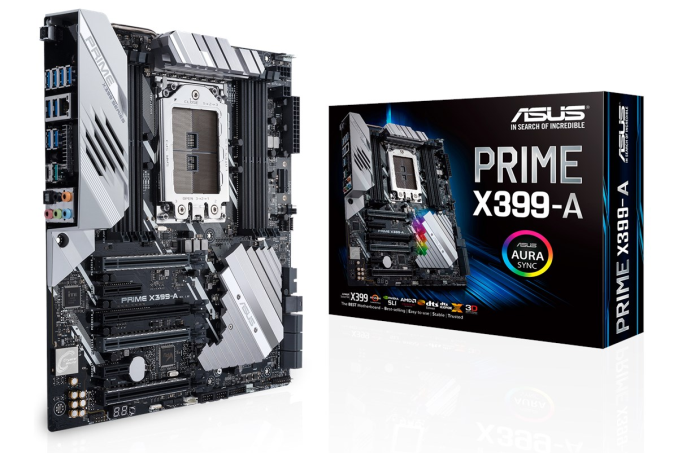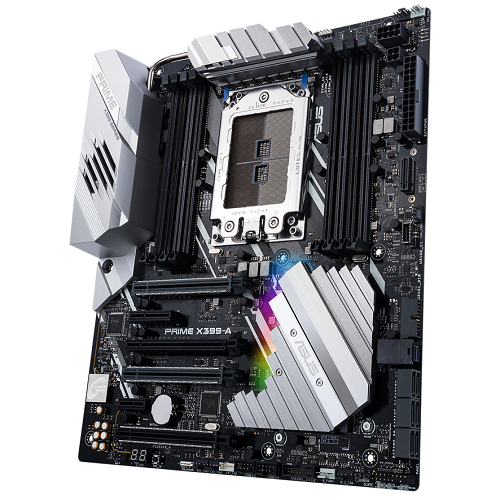An AMD Threadripper X399 Motherboard Overview: A Quick Look at Seven Products
by Ian Cutress & Joe Shields on September 15, 2017 9:00 AM ESTASUS Prime X399-A
By contrast to the comparison between the two ASRock motherboards, ASUS has positioned their first two products further apart from each other. The Prime X399-A is aimed more at an entry into X399, although the ‘entry’ moniker might be misleading: these X399 motherboards are still being stacked to the hilt in functionality even for the ‘cheaper’ models.
The ASUS Prime X399-A follows previous Prime-A products in a white/grey styling, using a brushed metal and angled design across the heatsinks and PCB to show that this motherboard means business (or something like that). The key features of the Prime X399-A are going to be the extended power delivery heatsink arrangement, U.2 and M.2 storage support, ASUS’ upgrade to the Realtek audio and RGB support.
The baseline specifications for the majority of Threadripper boards are here: a full complement of 8 DIMMs for memory, a good set of PCIe slots for multiple-add in cards, SATA storage, Ethernet and USB 3.1 (10 Gbps) support. ASUS, by comparison to the ROG Zenith, has stripped this model down: there’s only one Ethernet port, no WiFi, only two M.2 slots, fewer USB ports (but still over a dozen), and fewer PCIe slots with reinforcement. Threadripper is a high-end product, so doing a complete strip down to the bare essentials negates the high-end aspect of the platform. Perhaps a surprise over the ROG is that the Prime-A has a two-digit LED debug, while the ROG does not.
Going through the board in detail, starting at the top, is the VRM arrangement. This is an eight-phase design, with a dual connected heatsink reaching around the memory slots to the rear panel, which has a small 40mm fan. On the other side of the socket, ASUS has placed both EPS connectors (one 8-pin, one 4-pin) on the top right of the board with the 24-pin ATX connector directly below. While this area is where ASUS normally places some of its more esoteric features, such as PCIe slot disabling switches, there is no need to here. Perhaps a little strange to most will be the placement of the M.2 slot underneath the 24-pin, which requires the M.2 be placed ‘standing-up’ and out of the board. ASUS provides an M.2 bracket to assist in rigidity here.
Below the M.2 is the onboard USB 3.1 (10 Gbps) header from the chipset, which is slowly becoming adopted as the onboard standard, with a small number of chassis manufacturers adopting it for adding front-panel ports. This is followed by one of the two USB 3.0 headers, a U.2 port, and six SATA ports.
The chipset heatsink, as shown by the RGB on the picture, houses a few LEDs to adjust the aesthetic through the onboard AURA SYNC software. The heatsink also houses an M.2 slot, like the ROG, and helps provide additional cooling for it if needed.
To the left of the chipset are the PCIe slots. In order to save some cost and provide a little bit of product differentiation, ASUS has decided to only equip three of the full-length slots with a reinforcement guard, although all four full-length slots are connected to the CPU. The full length slots are provided as x16/x8/x16/x8, and when users equip multiple graphics cards, the slots with the reinforcement guard are the best ones to use. The one without the guard is not worse in any way, however in a two or three card system, using x16/x16 or x16/x16/x8 is usually preferred to x16/x8 or x16/x8/x8 due to the slot spacing arrangement. There is an additional PCIe 2.0 x4 from the chipset present as well.
Below the PCIe slots are the onboard headers, including USB 3.0 headers, fan headers, RGB LED headers and a two-digit debug. This is also paired with a power button to test the motherboard when a hand is in the case but the case is not hooked up. To the right of this is the onboard audio, to which ASUS uses their customized version of the Realtek ALC1220. This is combined with upgraded filter caps, PCB separation, an EMI shield and a DTS software stack.
The rear panel, due to the positioning of the board, might look a little bare compared to the ROG. There is the BIOS reset button, a total of eight USB 3.0 ports, the gigabit Ethernet port provided via the Intel I211-AT controller, a USB 3.1 Type-A port and Type-C port from an ASMedia controller, and the audio jacks with SPDIF output.
| ASUS Prime X399-A | |
| Warranty Period | 3 Years |
| Product Page | Link |
| Price | $349.99 |
| Size | E-ATX |
| CPU Interface | TR4 |
| Chipset | AMD X399 |
| Memory Slots (DDR4) | Eight DDR4 Supporting 128GB Quad Channel Up to 3600 MHz (OC) |
| Network Connectivity | 1 x Intel I211-AT GbE |
| Wireless Network | N/A |
| Onboard Audio | SupremeFX S1220A |
| PCIe Slots for Graphics (from CPU) | 4 x PCIe 3.0 x16 Supports SLI/CF |
| PCIe Slots for Other (from Chipset) | 1 x PCIe 2.0 x4 (max) 1 x PCIe 2.0 x1 |
| Onboard SATA | 6x Supporting RAID 0/1/10 |
| Onboard SATA Express | None |
| Onboard M.2 | 2 x PCIe 3.0 x4 - NVMe or SATA |
| Onboard U.2 | 1 x |
| USB 3.1 | 1 x Type-A Port 1 x Type-C Port |
| USB 3.0 | 8 x Rear Panel Ports 2 x Headers |
| USB 2.0 | 2 x Headers |
| Power Connectors | 1 x 24-pin EATX 1 x 8-pin ATX 12V 1 x 4-pin ATX 12V |
| Fan Headers | 1 x M.2 1 x CPU 1 x CPU OPT 3 x Chassis 1 x AIO_PUMP 1 x 5-pin EXT_FAN |
| IO Panel | 1 x Intel NIC 1 x USB 3.1 Type-A 1 x USB 3.1 Type-C 8 x USB 3.0 Ports 1 x Optical S/PDIF out 5 x Audio jack 1 x USB BIOS Flashback Button |













99 Comments
View All Comments
Vorl - Friday, September 15, 2017 - link
Heads up, the X399 Taichi product link is linked to the pro gaming motherboard link.milkod2001 - Friday, September 15, 2017 - link
Grossly overpriced boards. Cay they drop this LED nonsense & ugly plastics and make proper boards at reasonable $250?DanNeely - Friday, September 15, 2017 - link
The RGB cancer isn't why these boards are so expensive. It's stupid, but only adds a few dollars to the cost; not a few hundred.It's all the extra PCB layers they need to support the 4000 connections to the CPU socket and route all the extra PCIe lanes. Limiting the number of PCIe lanes in mainstream chips is as much about being able to use smaller sockets and fewer PCB layers to keep board costs down as it is a desire on AMD and Intel's part to upsell to X299/X399 systems. The fact that the mobo vendors are probably expecting to sell dozens of mainstream boards for every one of these halo products doesn't help either because it means that the R&D costs can't be spread anywhere near as widely.
For the two boards that have them, the $100 for a 10GB NIC doesn't help any.
tamalero - Sunday, September 17, 2017 - link
Still annoying and useless. They just wanted to appeal the extra gaming segment when this entire system is not for gaming.Now add the fact that almost every goddarn high end videocard AND memory now have shitty RGB lights as well.
Its a waste of power.
CheapSushi - Sunday, September 17, 2017 - link
Are you assuming enthusiasts are all just gamers? You can be an enthusiast that loves gaming AND content creation. If you want no-nonsense then maybe go EPYC instead (YES, it is a workstation platform too, not just server): http://b2b.gigabyte.com/Server-Motherboard/MZ31-AR...mapesdhs - Tuesday, September 19, 2017 - link
Amazing how many people just assume that a PC user is either a gamer or not a gamer. There's a lot of crossover with content creation these days, and also people who stream. Being able to play a game, record the gameplay, convert a previous session and upload it to YT/etc. will be a boon for those who make a living doing such things.CheapSushi - Sunday, September 17, 2017 - link
Finally a voice of reason for the naggers.ddarko - Friday, September 15, 2017 - link
Anyone interested in pairing the Asus Zenith Extreme with the Threadripper version of the Noctua NH-U14S should note that the cooler blocks the first PCI-E x16 slot on the board. Noctua says Asus didn't follow the AMD clearance guidance on this board; you can see in the pic that the top slot is very very close to the CPU bracket.glennst43 - Friday, September 15, 2017 - link
NH-U12S TR4-SP3 will fit though: http://noctua.at/en/nh-u12s-tr4-sp3/specification. I read a German article that showed that this cooler provides very similar cooling perf and noise as compared to the 14S. I have 2 other systems that use variations of the 14s, and I can not find any noticeable noise difference. Still an unfortunate design decision from Asus.DanNeely - Friday, September 15, 2017 - link
Other than the MSI board, I notice that none of them are putting USB2 ports on the back panel. Does that mean the interference problems that some USB2 devices encountered in 3.0 ports have been fixed; or that the mobo makers just feel anyone who needs them can use an IO bracket attached to an onboard header?